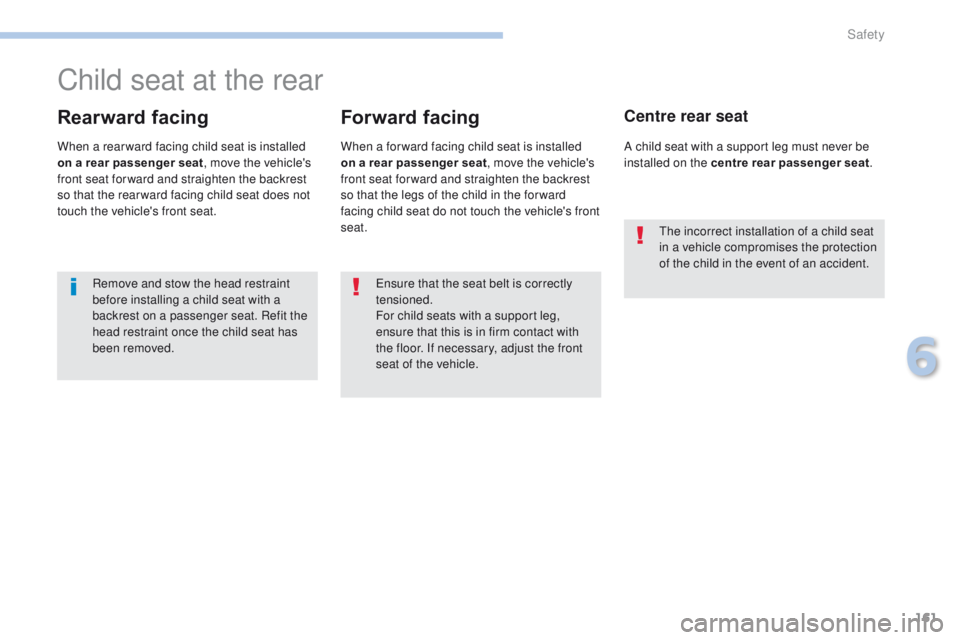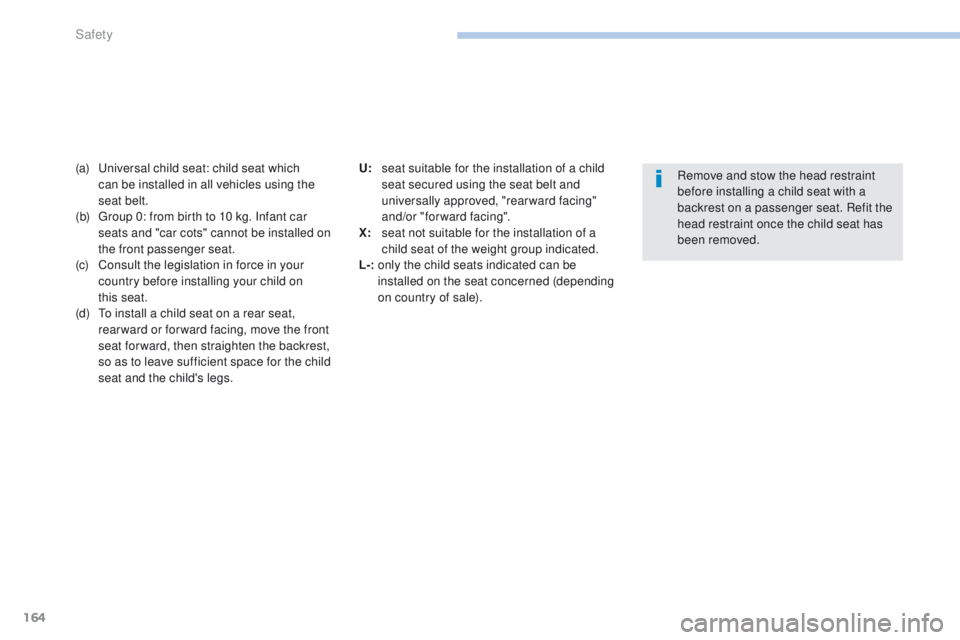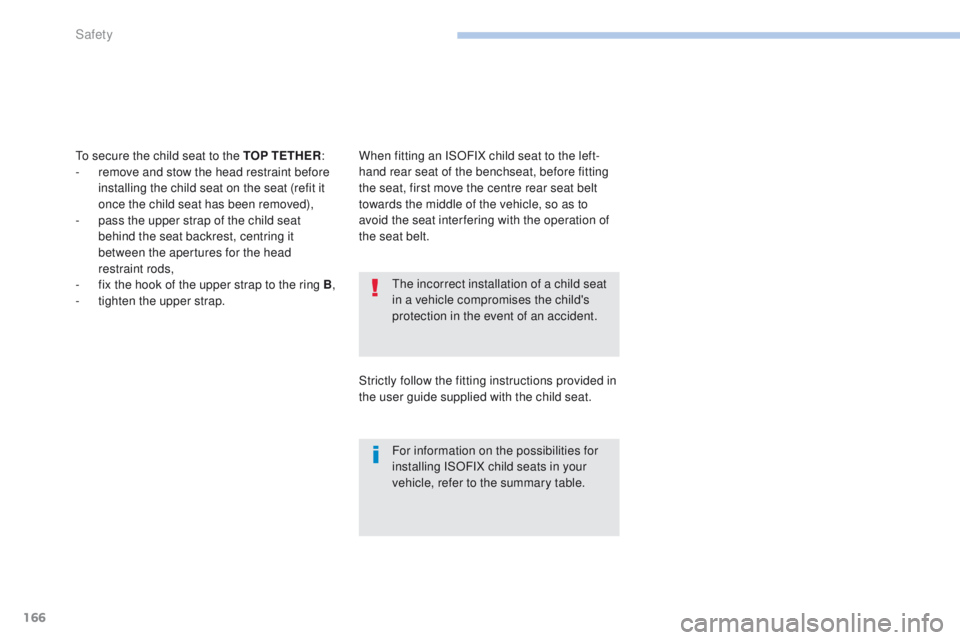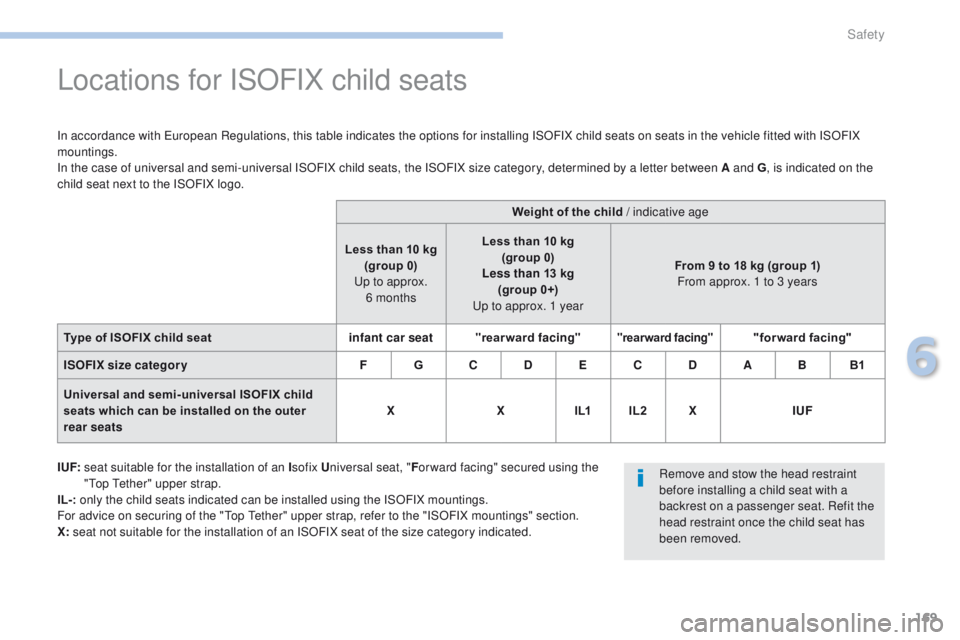Page 163 of 368

161
4008_en_Chap06_securite_ed01-2016
Child seat at the rear
Rearward facing
When a rear ward facing child seat is installed
on a rear passenger seat, move the vehicle's
front seat for ward and straighten the backrest
so that the rear ward facing child seat does not
touch the vehicle's front seat.
Forward facing
When a for ward facing child seat is installed
on a rear passenger seat , move the vehicle's
front seat for ward and straighten the backrest
so that the legs of the child in the for ward
facing child seat do not touch the vehicle's front
seat.
Centre rear seat
ensure that the seat belt is correctly
tensioned.
For child seats with a support leg,
ensure that this is in firm contact with
the floor. If necessary, adjust the front
seat of the vehicle.
Remove and stow the head restraint
before installing a child seat with a
backrest on a passenger seat. Refit the
head restraint once the child seat has
been removed. A child seat with a support leg must never be
installed on the centre rear passenger seat
.
th
e incorrect installation of a child seat
in a vehicle compromises the protection
of the child in the event of an accident.
6
Safety
Page 166 of 368

164
4008_en_Chap06_securite_ed01-2016
(a) universal child seat: child seat which can be installed in all vehicles using the
seat belt.
(b)
g
r
oup 0: from birth to 10 kg. Infant car
seats and "car cots" cannot be installed on
the front passenger seat.
(c)
C
onsult the legislation in force in your
country before installing your child on
this
seat.
(d)
t
o i
nstall a child seat on a rear seat,
rear ward or for ward facing, move the front
seat for ward, then straighten the backrest,
so as to leave sufficient space for the child
seat and the child's legs. Remove and stow the head restraint
before installing a child seat with a
backrest on a passenger seat. Refit the
head restraint once the child seat has
been removed.
U: s
eat suitable for the installation of a child
seat secured using the seat belt and
universally approved, "rear ward facing"
and/or "forward facing".
X:
s
eat not suitable for the installation of a
child seat of the weight group indicated.
L-:
o
nly the child seats indicated can be
installed on the seat concerned (depending
on country of sale).
Safety
Page 168 of 368

166
4008_en_Chap06_securite_ed01-2016
the incorrect installation of a child seat
in a vehicle compromises the child's
protection in the event of an accident.
For information on the possibilities for
installing ISOFIX child seats in your
vehicle, refer to the summary table.
to s
ecure the child seat to the TOP TETHER
:
-
r
emove and stow the head restraint before
installing the child seat on the seat (refit it
once the child seat has been removed),
-
p
ass the upper strap of the child seat
behind the seat backrest, centring it
between the apertures for the head
restraint rods,
-
f
ix the hook of the upper strap to the ring B,
-
t
ighten the upper strap. When fitting an ISOFIX child seat to the left-
hand rear seat of the benchseat, before fitting
the seat, first move the centre rear seat belt
towards the middle of the vehicle, so as to
avoid the seat inter fering with the operation of
the seat belt.
Strictly follow the fitting instructions provided in
the user guide supplied with the child seat.
Safety
Page 171 of 368

169
4008_en_Chap06_securite_ed01-2016
Locations for ISOFIX child seats
In accordance with european Regulations, this table indicates the options for installing ISOFIX child seats on seats in the vehicle fitted with ISOFIX
mountings.
In the case of universal and semi-universal ISOFIX child seats, the ISOFIX size category, determined by a letter between A and G , is indicated on the
child seat next to the ISOFIX logo.
Weight of the child / indicative age
Less than 10 kg (group 0)
u
p to approx. 6
monthsLess than 10 kg
(group 0)
Less than 13 kg
(group 0+)
up t
o approx. 1 yearFrom 9 to 18 kg (group 1)
From approx. 1 to 3 years
Type of ISOFIX child seat infant car seat "rearward facing"
"rearward facing""forward facing"
ISOFIX size categor y FG C D E C D A B B1
Universal and semi-universal ISOFIX child
seats which can be installed on the outer
rear seat s X
XI L1IL2 X IUF
I UF:
s
eat suitable for the installation of an I sofix Universal seat, " For ward facing" secured using the
"
to
p
t
e
ther" upper strap.
IL-: only the child seats indicated can be installed using the ISOFIX mountings.
For advice on securing of the "
to
p
t
e
ther" upper strap, refer to the "ISOFIX mountings" section.
X: seat not suitable for the installation of an ISOFIX seat of the size category indicated. Remove and stow the head restraint
before installing a child seat with a
backrest on a passenger seat. Refit the
head restraint once the child seat has
been removed.
6
Safety
Page 173 of 368
171
4008_en_Chap06_securite_ed01-2016
Child lock
Mechanical system to prevent opening of the rear doors using their interior controls.the control is located on the edge of each rear door.
Child lock on
F Move the control A towards position 1 .
Child lock off
F Move the control A towards position 2 .
6
Safety
Page 178 of 368
176
4008_en_Chap07_info-pratiques_ed01-2016
Removing a front or rear
wiper blade
F Raise the corresponding wiper arm.
F R emove the wiper blade, sliding it towards
the outside.
Changing a wiper
blade
Fitting a front or rear wiper
blade
F At the front, check the size of the wiper blade as the shorter blade is fitted on the
right-hand side of the vehicle.
F
P
ut the corresponding new wiper blade in
place and fix it.
F
F
old down the wiper arm carefully.
Automatic power cut-off to accessories
After the engine has stopped, when the
ignition switch is in the "ACC" position
(or the vehicle in "ACC" mode) you
can still use functions such as the audio
equipment, windscreen wipers, dipped beam
headlamps,
courtesy lamps, etc. for about
thirty
minutes.Cutting off
Once the thirty minutes have expired, the
power supply to the accessories will be
automatically cut off.
Restoring power
the power supply will be restored the next time
the ignition is switched on.
Practical information
Page 179 of 368

177
4008_en_Chap07_info-pratiques_ed01-2016
towing a trailer, a caravan, etc.
We recommend the use of genuine
PeugeOt towbars and their harnesses
that have been tested and approved
from the design stage of your vehicle
and that the fitting of the towbar is
entrusted to a P
e
uge
Ot
dealer or a
qualified workshop.
If the towbar is not fitted by a
P
e
uge
Ot
dealer, it is imperative that
it is fitted following the manufacturer's
instructions.
Your vehicle is primarily designed for
transporting people and luggage, but it may
also be used for towing a trailer.
Driving with a trailer subjects the towing vehicle
to more significant stress and its driver must be
particularly careful.
For more advice on driving when towing, refer
to the corresponding section.
For more information on Petrol weights
or
Diesel weights and in particular the towed
loads which apply to your vehicle, refer to the
corresponding section.
ta
ke care to comply with the gross train
weights indicated on the registration certificate
or in the technical data for your vehicle.
7
Practical information
Page 180 of 368

178
4008_en_Chap07_info-pratiques_ed01-2016
Advice on driving when towing
Distribution of loads
F Distribute the load in the trailer so that the heaviest items are as close as possible to
the axle and the nose weight approaches
the maximum permitted without exceeding
it.
Air density decreases with altitude, thus
reducing engine performance. Above
1
000 metres, the maximum towing load must
be reduced by 10
% of the gt
W a
nd so on for
every 1
000 metres of altitude.
For more information on Petrol weights or
Diesel weights and in particular the towed
loads which apply to your vehicle, refer to the
corresponding section.
Side wind
F take into account the increased sensitivity to side wind.
Cooling
towing a trailer on a slope increases the
temperature of the coolant.
As the fan is electrically controlled, its cooling
capacity is not dependent on the engine speed.
F
t
o l
ower the engine speed, reduce your
speed.
th
e maximum towed load on a long slope
depends on the gradient and the exterior
temperature.
In all cases, pay attention to the coolant
temperature.
F
I
f this message is displayed, stop your
vehicle as soon as it is safe to do so .
Braking
towing a trailer increases the braking distance.to l
imit heat build-up in the brakes, use of the
engine brake is recommended.
Ty r e s
F Check the tyre pressures of the towing vehicle and of the trailer, observing the
recommended pressures.
Lighting
F Check the lighting and signalling on the trailer and the adjustment of the vehicle's
headlamps.
For more information on Headlamp
adjustment , refer to the corresponding
section.
If the message flashes slowly, wait for the
engine to cool before topping up the level, if
necessary.
If the message flashes rapidly, contact a
P
e
uge
Ot
dealer or a qualified workshop
without delay.
the rear parking sensors will be
deactivated automatically when a
genuine P
e
uge
Ot
towbar is used.
Practical information